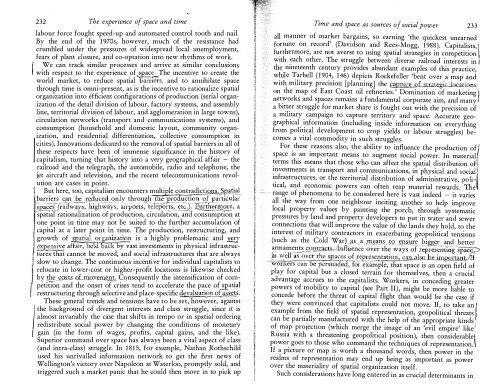The Condition of Postmodernity 13 - autonomous learning
The Condition of Postmodernity 13 - autonomous learning
The Condition of Postmodernity 13 - autonomous learning
You also want an ePaper? Increase the reach of your titles
YUMPU automatically turns print PDFs into web optimized ePapers that Google loves.
232 <strong>The</strong> experience <strong>of</strong> space and timelabour force fought speed-up and automated control tooth and nail.By the end <strong>of</strong> the 1970s, however, much <strong>of</strong> the resistance hadcrumbled under the pressures <strong>of</strong> widespread local unemployment,fears <strong>of</strong> plant closure, and co-optation into new rytms <strong>of</strong> wor.." We can track similar processes and arnve at sImIlar conclusIOnswith respect to the experience <strong>of</strong> .. spac . <strong>The</strong> incentive o. create theworld market, to reduce spatial barners, and to anlllhIate spa ethrough time is omni-present, as is the incentive to ationah ze spatIal .organization into efficient configurations <strong>of</strong> productIOn (senal organization<strong>of</strong> the detail division <strong>of</strong> labour, factory systems, and assemblyline territorial division <strong>of</strong> labour, and agglomeration in large towns),circlation networks (transport and communications systems), andconsumption (household and domestic layout, .community ?rgar:ization and residential differentiation, collectlve consumptIon m" cities). Innovations dedicated to the remval .<strong>of</strong> spatil barrier in all <strong>of</strong>these respects have been <strong>of</strong> immense sIglllficance I the hItory <strong>of</strong>capitalism, turning that history into a v ry geo !? raphIcal affaIr - therailroad and the telegraph, the automobIle, radIO and ele p hone, thejet aircraft and television, and the recent telecommUlllCatIons revolutionare cases in point.. . .But here, too, capitalism encounters multiple contr .adIctIons. S ..1lt1a .barriers can be r41,lced only through . t e po_ _()LEaXtlc.ularjPacesJrallys-; highays, airpri:s tIepoJ_!c.).: E.!!rtherm?r, aspatial rationalization <strong>of</strong> productIOn, cIrculatIon, and consump IOn atone point in time may not be suited to the f ,: rther accumul .atIon <strong>of</strong>capital at a later point in time. <strong>The</strong> production, restru tunng, andgrowth <strong>of</strong> g is a highly roblemạtIc .and ieXEen affair, held JJaCKby vast i ve tments m physIcal mfrastructurestliat cannot be moved, and socIal mfrastructures that are alwaysslow to change: <strong>The</strong> continuous incentive fo indi idal cpitalists torelocate in lower-cost or higher-pr<strong>of</strong>it locatIOns IS ltkewIse checkedby theSQ.sJs nLmoyement. S:0nsequently the intensification <strong>of</strong> COIpetitionand the onset <strong>of</strong> cnses tend to accelẹrate the pa. ce <strong>of</strong> £atIalrestructuring through selective and place-specIfic devaluatIs.<strong>The</strong>se general trends and tensions have to be set, howeve , aga .mtI the backgro nd <strong>of</strong> divergent inte : est and class s ruggle ?smce I ISalmost invanably the case that shIfts m tempo or m spatIal ordenngredistribute social power by changing the conditions <strong>of</strong> monetaryl gain (in the form <strong>of</strong> wages, pr<strong>of</strong>its, capital gaiI s, and the like).Superior command over space has always been a vItal aspect <strong>of</strong> cl ss(and intra-class) struggle. In 1815, for example, Nathan RothschIldused his unrivalled information network to get the first news <strong>of</strong>Wellington's victory over Napoleon at Waterloo, prom tly sol, andtriggered such a market panic that he could then move m to pIck upTime and space as sources <strong>of</strong> social power 233all manner <strong>of</strong> market bargains, so earning 'the quickest unearnedfortune on record' (Davidson and Rees-Mogg, 1988). caPitalists,\furthermore, are not averse to using spatial strategies in competition .with each other. <strong>The</strong> struggle between diverse railroad interests inthe nineteenth century provides abundant examples <strong>of</strong> this practice,while Tarbell (1904, 146) depicts Rockefeller 'bent over a map andwith military precision [planning] the a12t!!re.. oL-S.tr,ategicJo.cationson the map <strong>of</strong> East Coast oil refineries.' Domination <strong>of</strong> marketingI "networks and spaces remains a fundamental corporate aim, and manya bitter struggle for market share is fought out with the precision <strong>of</strong>a military campaign to capture territory and space. Accurate geographicalinformation (including inside information on everythingfrom political development to crop yields or labour struggles) becomesa vital commodity in such struggles.For these reasons also, the ability to influence the production <strong>of</strong>(space is an important means to augment social power. In material/terms this means that those who can affect the spatial distribution <strong>of</strong>il;investments in transport and communications, in physical and social!!'infrastructures, or the territorial distribution <strong>of</strong> administrative, poliJtical, and economic powers can <strong>of</strong>ten reap material rewards. <strong>The</strong>1- range <strong>of</strong> phenomena to be considered here is vast indeed - it variesall the way from one neighbour inciting another to help improvelocal property values by painting the porch, through systematicpressures by land and property developers to put in water and sewerconnections that will improve the value <strong>of</strong> the lands they hold, to theinterest <strong>of</strong> military contractors in exacerbating geopolitical tensions(such as the Cold W
















